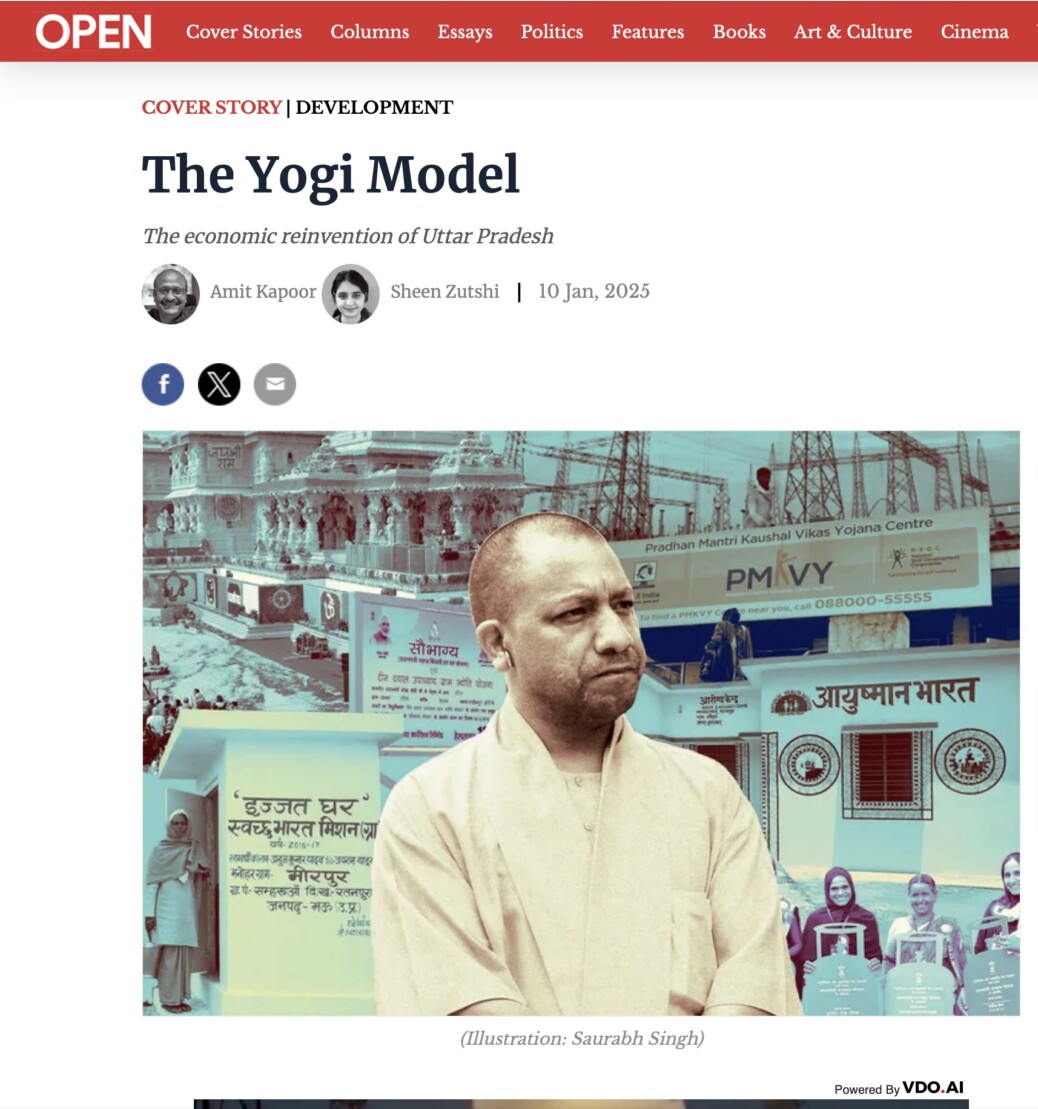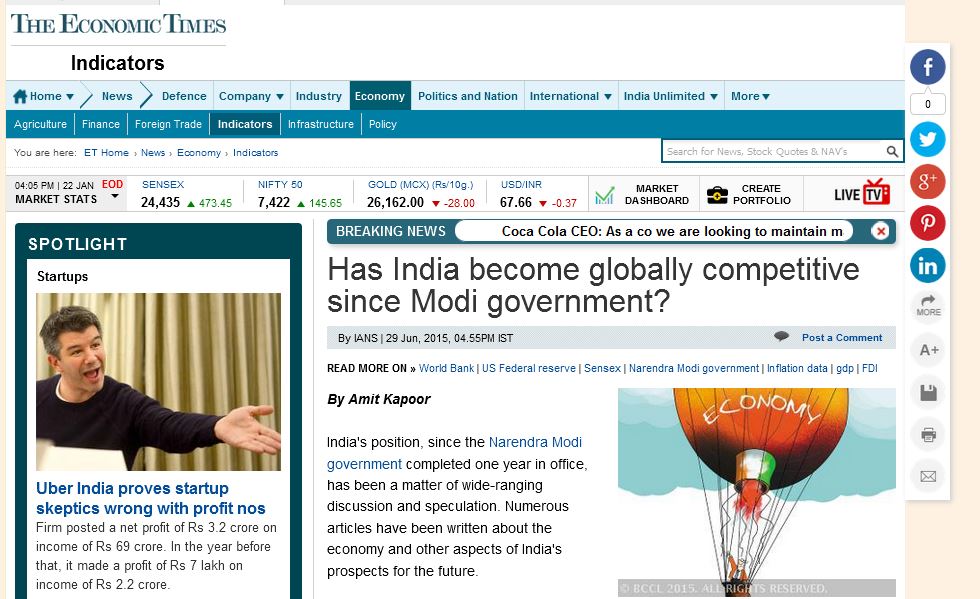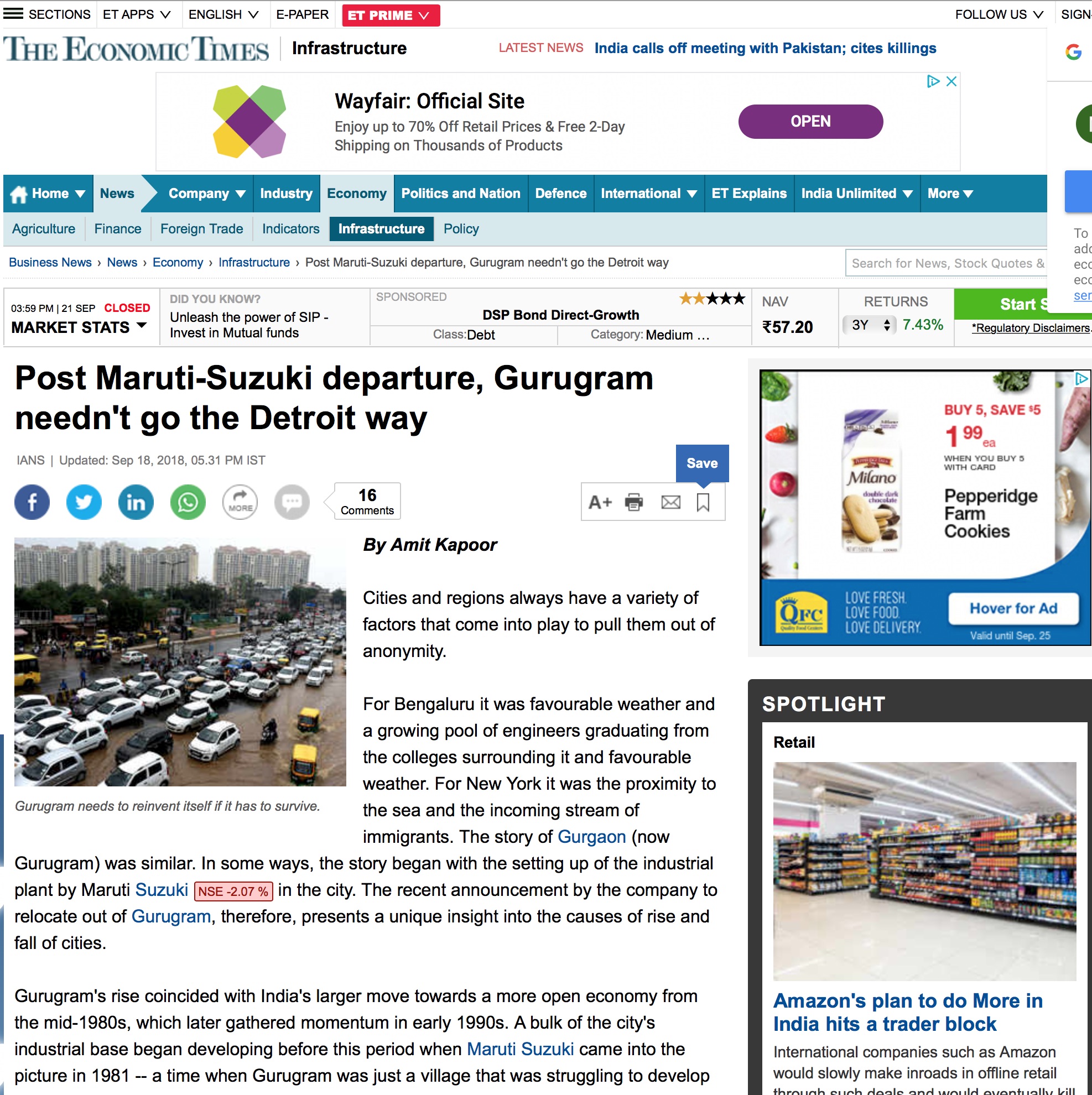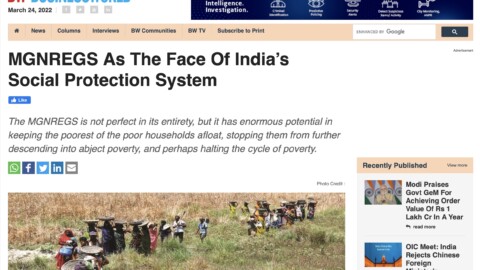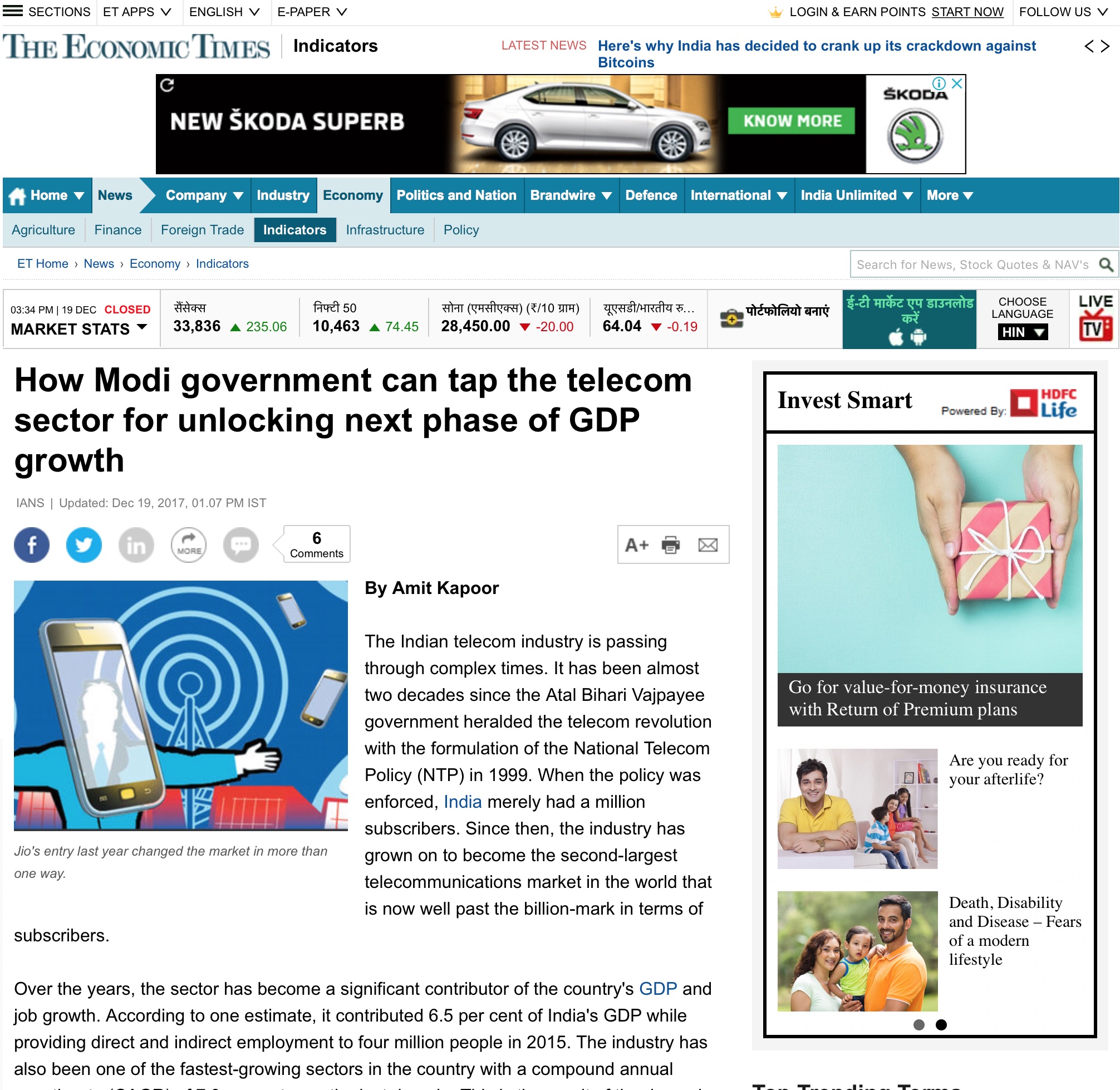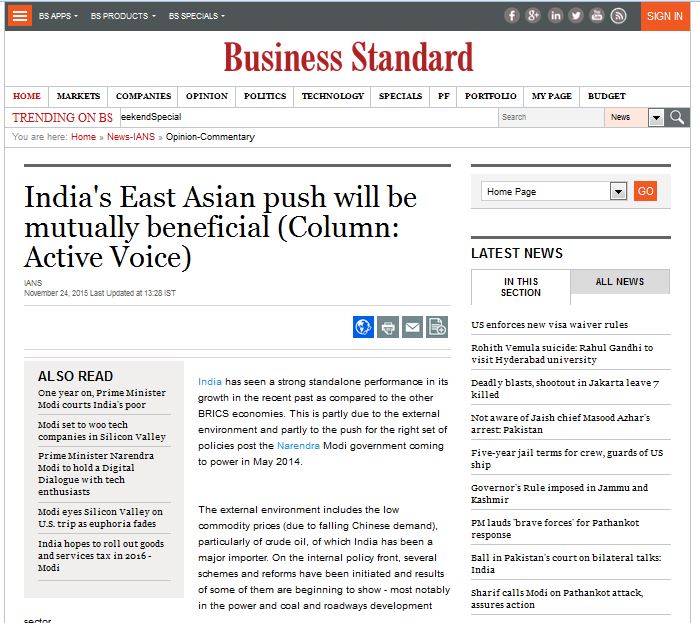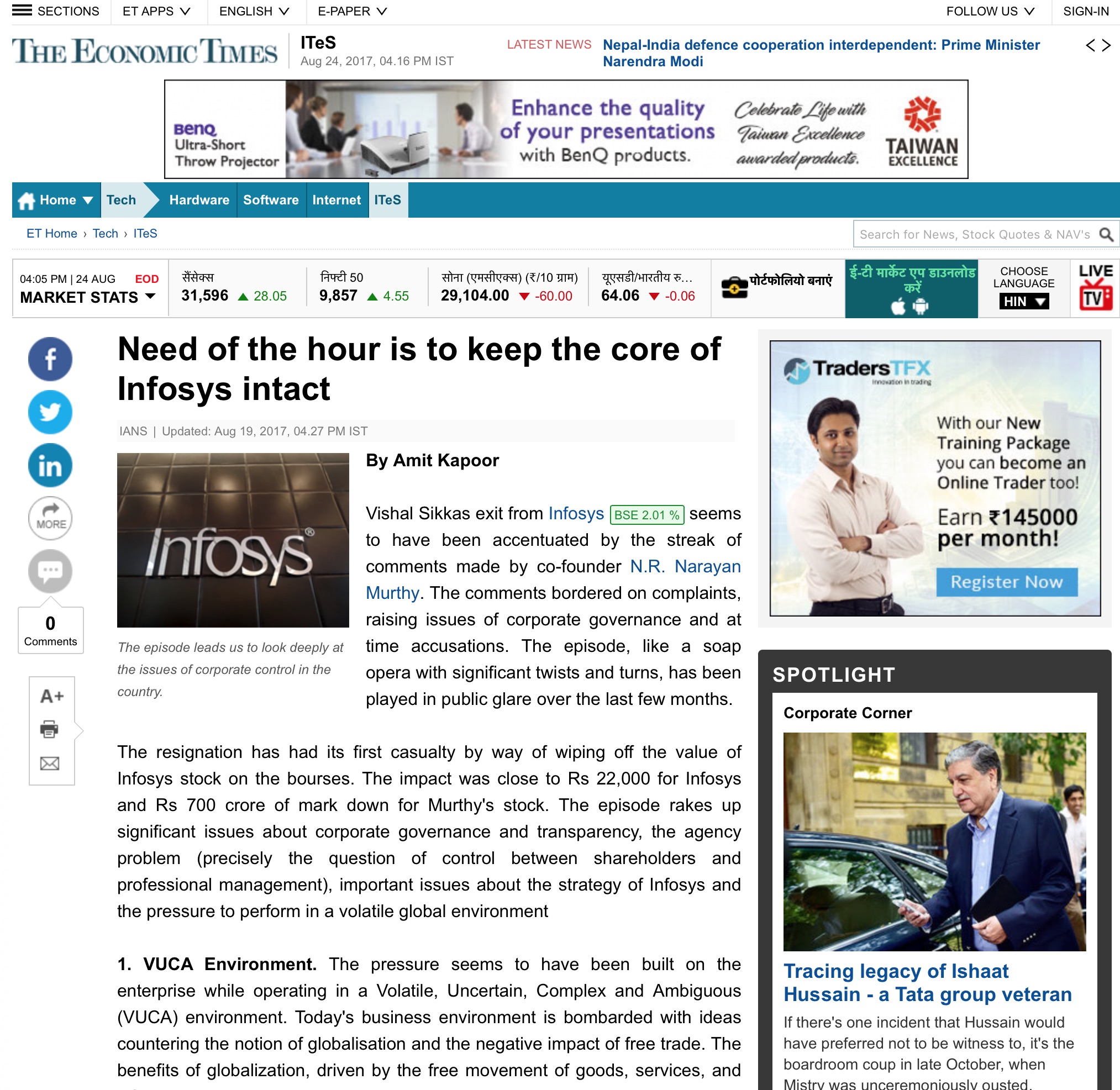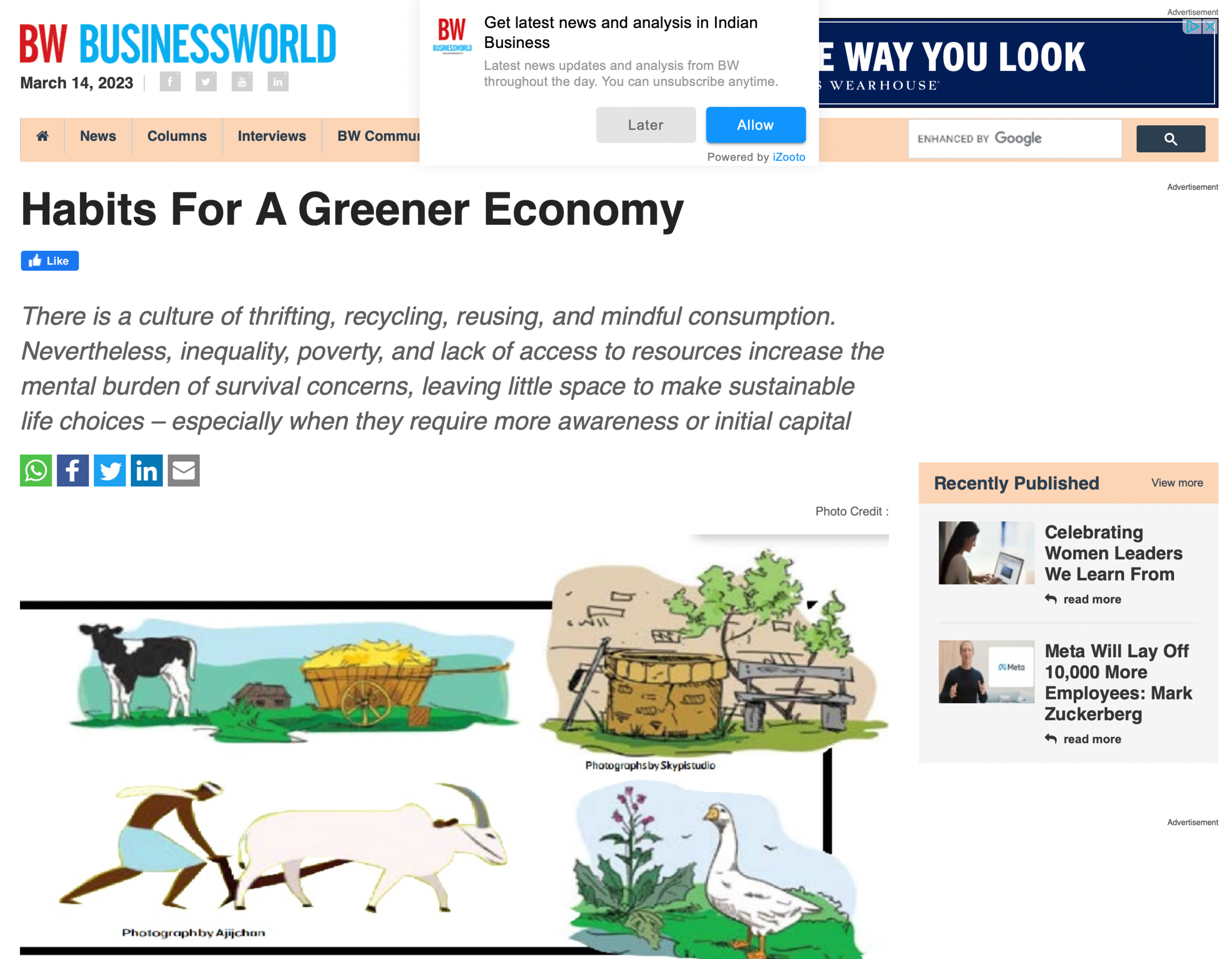The economic reinvention of Uttar Pradesh
By Amit Kapoor and Sheen Zutshi
Uttar Pradesh: Transforming into an Economic and Innovation Powerhouse
Uttar Pradesh, the fifth-largest economy in India with a GDP of USD 170 billion, stands as a testament to the nation’s economic diversity. Home to 16.97% of India’s population, if Uttar Pradesh were a country, its GDP would rival Qatar’s. In contrast, its population would be equivalent to the combined totals of Germany, the United Kingdom, and France. The state is transforming remarkably, driven by a services sector and a proactive approach to fostering innovation. With a strong focus on promoting start-ups and enhancing its innovative capacity, Uttar Pradesh is steadily building an enabling ecosystem that positions it as a key player in India’s economic and entrepreneurial landscape.
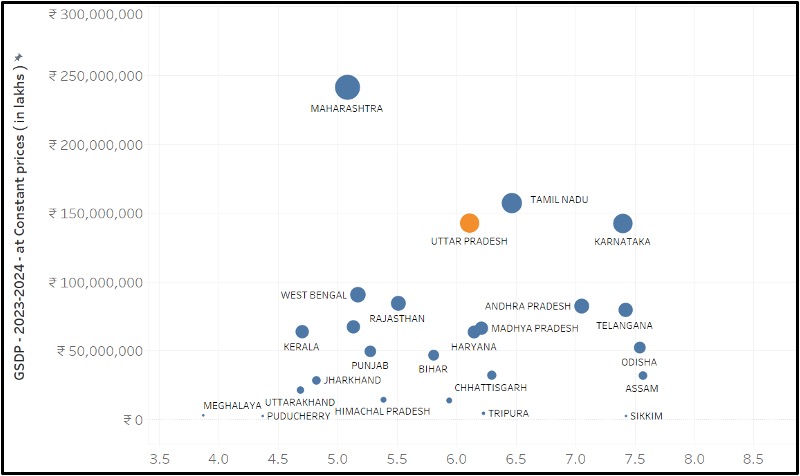
Uttar Pradesh’s economy has witnessed a significant transformation, driven by a dynamic shift in the composition and growth of its key sectors. The services sector dominates the state’s Gross State Value Added (GSVA), contributing 47.50%, reflecting the expanding role of trade, transport, financial services, and real estate. The industry sector, accounting for 30.44% of GSVA, has seen a notable boost, with the manufacturing sector—making up 14.5%—growing at an impressive CAGR of 6.08% between 2018-19 and 2023-24. This growth is fueled by initiatives promoting industrial parks, ease of doing business, and targeted incentives. Meanwhile, the agriculture and allied sector, contributing 22.06% to GSVA, has grown steadily at a CAGR of 5.95%, supported by diversification into allied activities like dairy, fisheries, and horticulture, alongside productivity-enhancing policies. Despite a comparatively moderate growth rate of 4.88% CAGR, the services sector remains the backbone of Uttar Pradesh’s economy, underscoring the state’s balanced growth across sectors and its emergence as a robust economic powerhouse.
Uttar Pradesh has demonstrated a significant improvement in labour force participation, reflecting the success of targeted government initiatives aimed at skill development and employability. The Labor Force Participation Rate (LFPR) for the 15–59-year age group rose sharply from 46.1% in 2017-18 to 58.6% in 2023-24. A noteworthy surge in female LFPR—from 14.2% to 35.8%—indicates greater inclusion of women in the workforce, while male LFPR improved from 77.5% to 82.2%.
The most striking improvement in LFPR by education level was seen among individuals with Diploma/Certificate Courses and higher secondary education. For those with Diploma/Certificate qualifications, the LFPR increased from 70.8% to 84.5%, while for higher secondary graduates, it rose from 36.8% to 48.4%. These gains can be attributed to the successful implementation of initiatives such as Pradhan Mantri Kaushal Vikas Yojana (PMKVY) and the Uttar Pradesh Skill Development Mission (UPSDM). Under PMKVY, Uttar Pradesh has emerged as a leading state, with robust performance in skilling youth through demand-driven training programs aligned with industry needs. Similarly, the state’s dedicated skill development mission has focused on equipping individuals with job-ready skills and fostering employability in high-growth sectors like manufacturing and services.
Among those with higher education (graduates and postgraduates), the LFPR increased by 6 percentage points, signalling incremental success in bridging the gap between advanced qualifications and workforce participation. These efforts are closely linked to the broader decline in unemployment, which fell from 6.9% in 2017-18 to 3.4% in 2023-24. By enhancing workforce participation through targeted skilling and training programs.
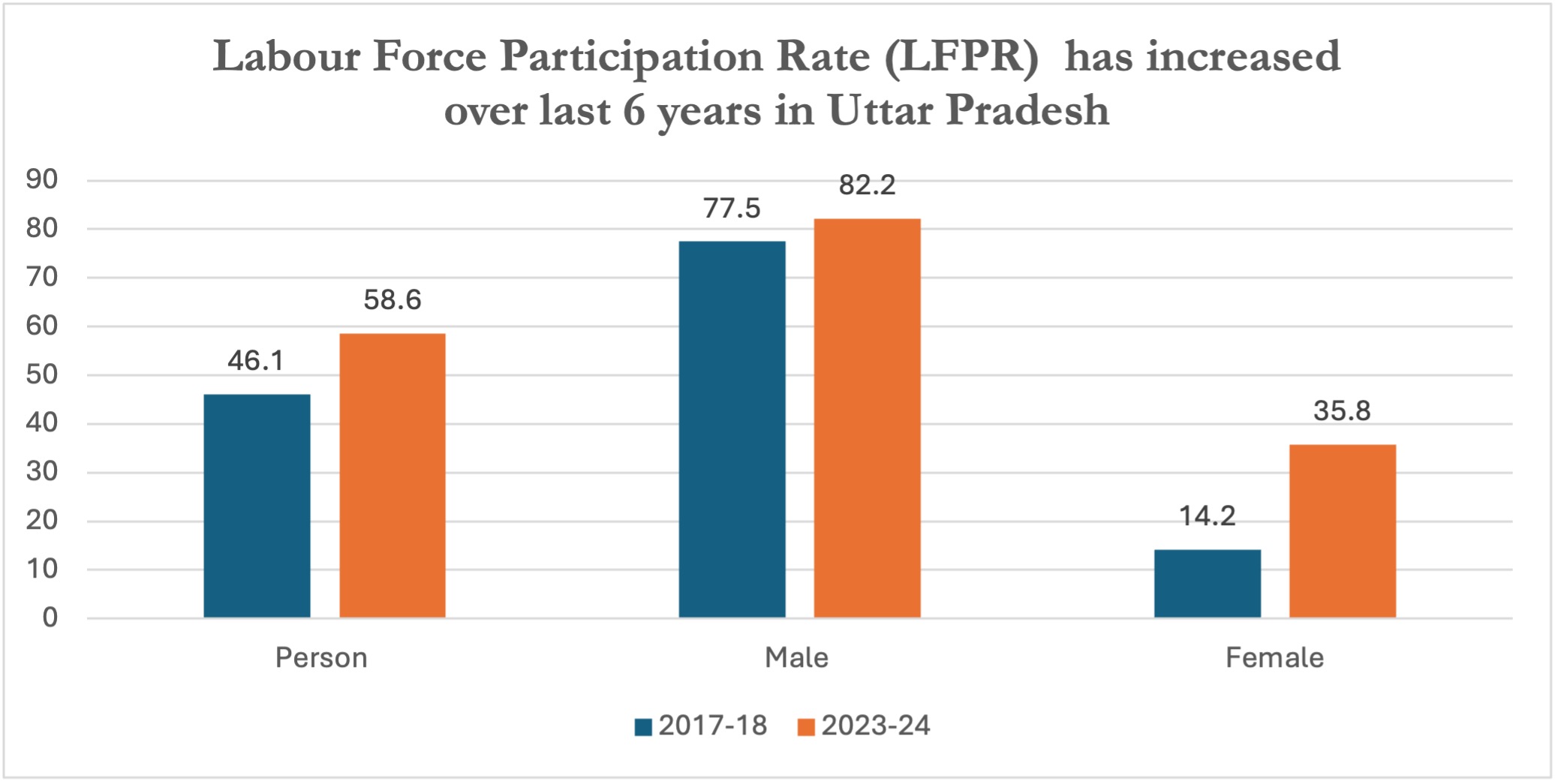
These changes are closely linked with Uttar Pradesh’s effort to reduce unemployment, as highlighted by the PLFS. The state’s unemployment rate for individuals aged 15–59 years dropped from 6.9% in 2017-18 to 3.4% in 2023-24. This impressive decline reflects a reduction of over 50% in just six years. Rural areas saw the most remarkable improvement, with unemployment falling from 6% to 2.5%. Urban areas also significantly decreased, from 10.1% in 2017-18 to 7.1%in 2023-24. These figures underscore the efforts of Uttar Pradesh’s targeted initiatives to create employment opportunities across both rural and urban regions. State has significantly reduced unemployment across all educational categories, as reflected in the PLFS data. Among the least educated, the improvements are particularly remarkable. Unemployment for those classified as “not literate” dropped from 1.9% in 2017-18 to a negligible 0.1% in 2023-24, indicating the effectiveness of rural employment schemes and labour-intensive programs. Similarly, individuals with education up to the primary level saw unemployment fall dramatically from 5.3% to 1% during the same period. For those with secondary and higher secondary education, unemployment rates decreased significantly, from 5.8% and 9.6% to 2% and 3.4%,respectively, showcasing the impact of skill development and job-oriented training initiatives.
At the higher education level, the trends reveal a mixed picture. Unemployment among diploma holders halved, from 14.5% to 7.7%, and for graduates, it declined from 16.7% to 13.6%, demonstrating the success of industrialization and entrepreneurship incentives. However, the unemployment rate for postgraduates and above slightly increased, from 12.7% to 14.6%, suggesting a potential mismatch between advanced qualifications and available opportunities. While the overall reduction across education levels highlights the effectiveness of Uttar Pradesh’s policies, the challenges highly educated individuals face underscore the need for a stronger focus on creating high-skill jobs and fostering innovation-driven industries.
Uttar Pradesh has also made significant strides in reducing multidimensional poverty and has improved on important social progress indicators. According to the Multidimensional Poverty Index (MPI) report released last year by NITI Aayog, the state has shown the fastest reduction in MPI value across India, with 34.3 million people escaping multidimensional poverty between 2015-16 and 2019-21. The state’s Head Count Ratio (HCR) of multidimensional poverty has also dropped sharply from 37.68% to 22.93%, marking a reduction of 14.75 percentage points. This decline is reflected in targeted efforts to enhance social progress, including improved access to basic education, healthcare, water facilities, sanitation, and rural electrification.
The state has witnessed remarkable improvements in key indicators of basic needs and living standards, as reflected in the National Family Health Survey (NFHS) data. Comparing data for NFHS-4 (2014-15) to NFHS-5 (2019-21) for UP, it can be observed that the state has made significant strides in areas like sanitation, electricity, clean cooking fuel, and health insurance coverage, reflecting the impact of targeted government initiatives.
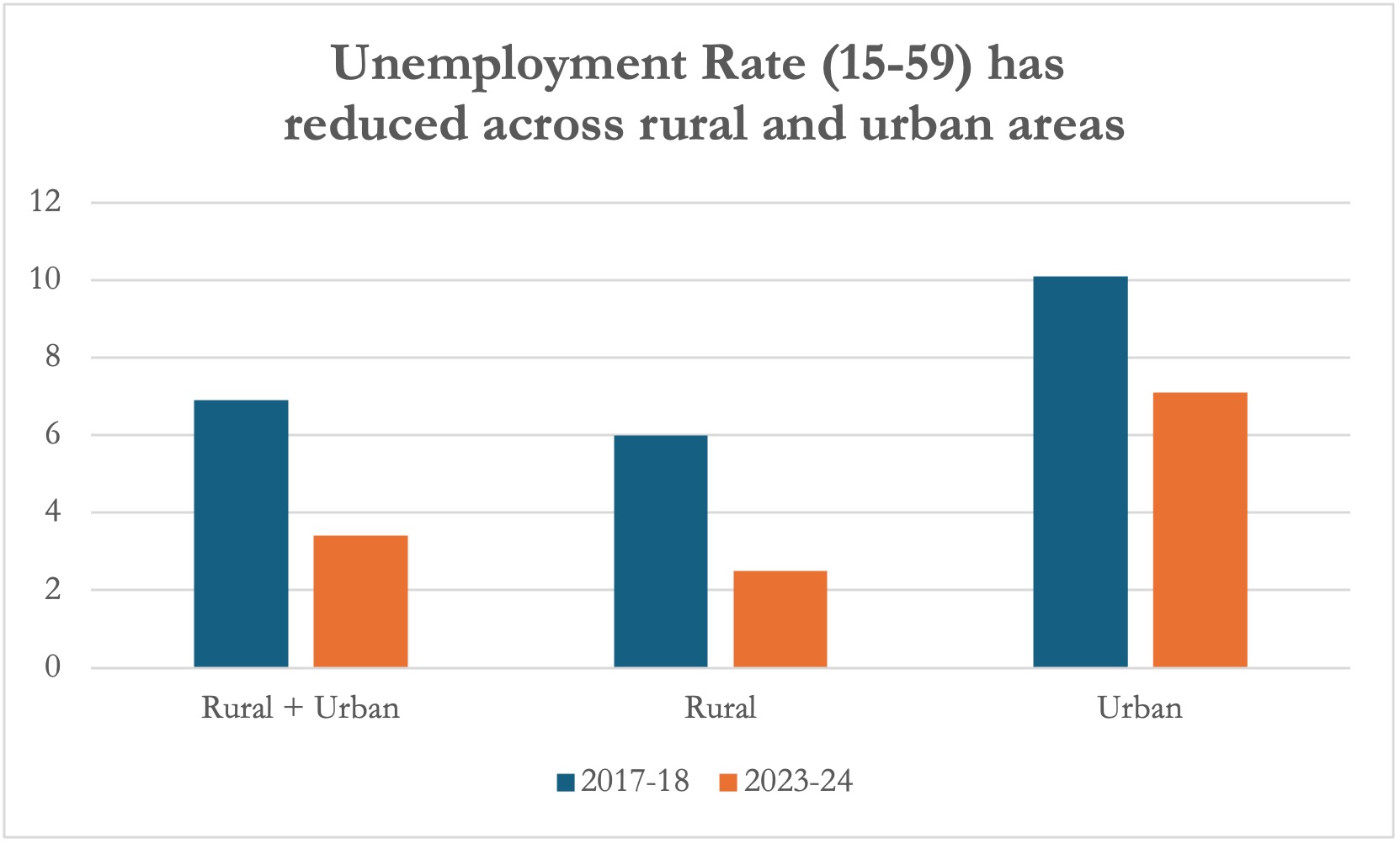
One of the most notable achievements is the substantial increase in households with improved sanitation facilities, which rose from 36.4% in NFHS-4 to 68.8% in NFHS-5. In rural areas, where toilet infrastructure was historically inadequate, households with access to improved sanitation facilities rose sharply from 23.1% in NFHS-4 to 64.8% in NFHS-5.
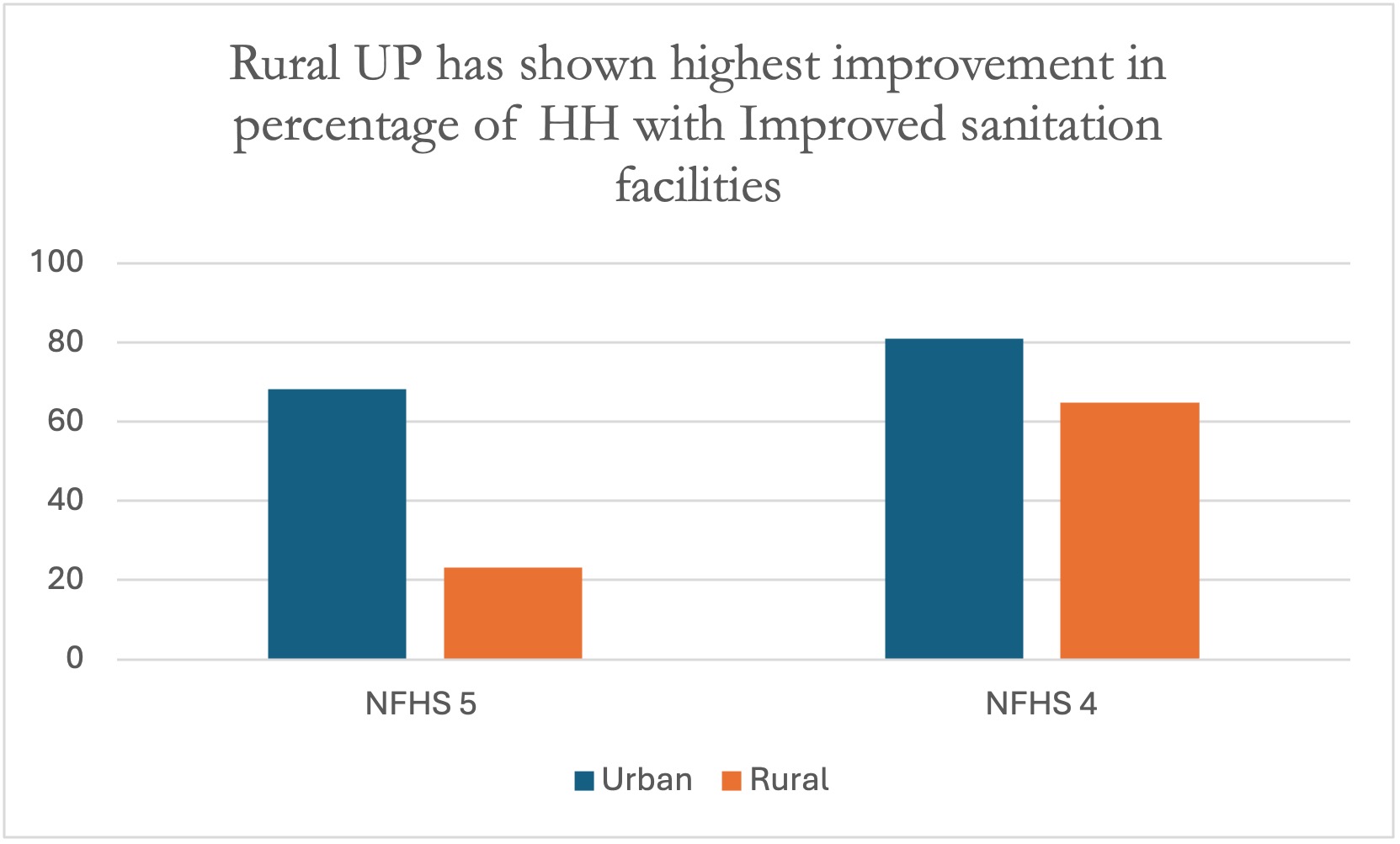
This remarkable transformation underscores the success of targeted initiatives under the Swachh Bharat Abhiyan (Gramin), which focused on toilet construction, behavioural change campaigns, and robust monitoring mechanisms to eliminate open defecation. Urban areas also witnessed significant progress, with households accessing improved sanitation increasing from 68.3% in NFHS-4 to 80.9% in NFHS-5. This improvement reflects the state’s efforts to expand urban sanitation coverage, including implementing waste management systems, provision of community toilets, and sanitation programs tailored to underserved areas such as slums. Most districts in Uttar Pradesh have shown substantial progress in sanitation indicators, bridging the urban-rural divide.
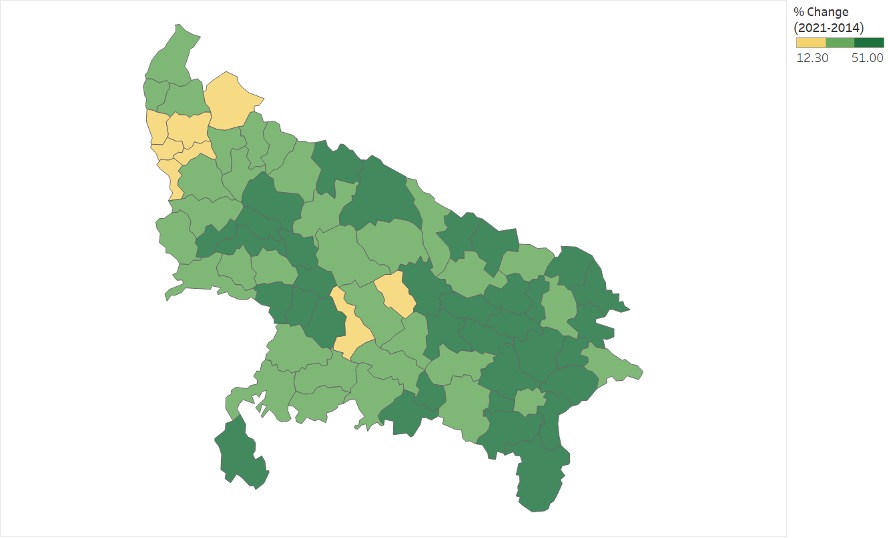
Highest Improvement in Household Access to Sanitation Facilities across UP Districts
This improvement has been driven by a concerted focus on building sanitation infrastructure, awareness campaigns about hygiene, and government subsidies for household toilets. These gains in sanitation facilities have had a cascading effect on public health, reducing the prevalence of waterborne diseases and improving the quality of life for millions across the state. Uttar Pradesh’s achievements in sanitation are pivotal for sustaining long-term development and meeting key SDG goals of 2030.
Similarly, the proportion of households with access to electricity grew from 72.6% to 91%, driven by schemes like Saubhagya Yojana, which aimed to provide universal electricity access. There has also been notable progress in adopting clean cooking fuels, with households using such fuels increasing from 32.7% to 49.5%. This growth reflects the efforts of the Ujjwala Yojana, which subsidized LPG connections for low-income households, reducing dependence on traditional biomass fuels and improving health outcomes, especially for women. Furthermore, the percentage of households with at least one member covered by a health insurance or financing scheme surged from 6.1 to 15.9, driven by initiatives like Ayushman Bharat and state-specific health coverage programs, ensuring financial protection against medical expenses.
The State has made significant improvements and remarkable strides in economic growth, social development, and infrastructural advancement in recent years. Considerable progress in employment generation, poverty reduction, and basic amenities like sanitation and electricity highlight the state’s commitment to improving the ease of living for its citizens. However, while many indicators show notable improvement, further efforts are needed in key areas such as reducing anaemia among women, improving child nutrition, and enhancing learning outcomes. Strengthening the Gross Enrollment Ratio (GER) in higher education will also be critical to sustaining sectoral transformations and driving inclusive growth. The state’s focus on innovation is evident in the rise in R&D expenditure, which has increased from ₹371.9 crores to ₹1,002 crores, reflecting a more than 2.5x jump. This strategic investment in research and innovation is vital for fostering a knowledge-driven economy. While Uttar Pradesh ranks 10th in India in terms of overall FDI inflows, its share remains at just 1%, indicating the need for further efforts to attract investment. Uttar Pradesh has made significant progress on the entrepreneurship front, with 11,336 DPIIT-recognized startups, positioning itself as a growing hub for innovation and enterprise.
Tourism is also significantly contributing to the economy of Uttar Pradesh, with the state reaching an impressive total of 476.1 million visitors between January and September 2024. Ayodhya, recognized as the spiritual hub of the area, has taken the lead as the most popular destination, surpassing the renowned Taj Mahal in Agra. The city attracted 135.5 million domestic tourists and 3,153 international travellers during this period, largely due to the recent inauguration of the Ram Temple. Meanwhile, Agra saw a total of 125.1 million visitors, comprised of 115.9 million domestic tourists and 924,000 international guests. These achievements underscore Uttar Pradesh’s multifaceted progress, reflecting its growing role as a hub of tourism, innovation, and inclusive development while charting a clear path toward sustained economic and social development.
The article was published with Open Magazine on January 10, 2025.
